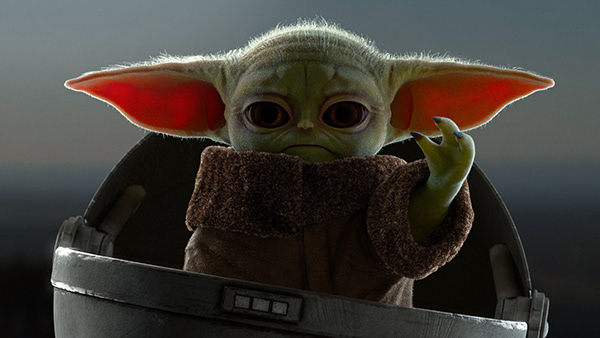‘The Mandalorian’: The Journey of A Vigilante Bounty Hunter

Photo Credit: DreedX / Disney The Mandalorian
My take on Yoda’s race baby. Rendered in Octane in Cinema4D, sculpted in ZBrush, retopology was done in Maya, Texturing in Substance Painter.
February 9, 2021
The highly anticipated second season of “The Mandalorian,” the biggest original tv series launched by Disney+, premiered on October 30 of last year. Created by Jon Favreau and Dave Filoni, this Star Wars spin-off show debuted last year on Disney+ and took the Internet and the Star Wars fandom by storm. With a 93% on Rotten Tomatoes, the first season of “The Mandalorian” holds a high standard for the new season. (Minor, basic plot-line spoilers ahead.)
As a non-Star Wars fan myself, I was skeptical of the hype that surrounded this only eight episode show. I had seen some Baby Yoda memes and decided to check out the show featuring this infamous and adorable Internet character. Before watching the show, I did not have high standards since I had not watched a single Star Wars movie in my life, but after binge watching the entire first season in two days, I was impressed by the show. This live-action show combines both action-filled scenes with more thought-provoking scenes to create a balanced storyline that truly showcases the complexity and depth of the main character. Moreover, the show’s CGI and special effects add to the world of the Mandalorian and add dimension to the realness of the setting. It definitely is a must-watch for both non-Star Wars fans and Star Wars fans, as the show incorporates a fair amount of Star Wars references and elements to intrigue Star Wars fans, while viewers who have not watched a single Star Wars movie will still be able to follow along and enjoy the series.
Set five years after the events of “Return of the Jedi” and the fall of the Empire, but before “The Force Awakens,” this tv series surrounds the Mandalorian (Pedro Pascal), a bounty hunter living in the outer reaches of the galaxy. He is hired to capture a bounty named “The Child,” but makes the split second decision to go on the run and protect him instead. The series then follows the Mandalorian’s journey to return the Child back to his own kind, with the help of friends made along the way and the obstacles he has to overcome in order to escape the people that initially hired the Mandalorian to retrieve the Child.
The show’s main character, the Mandalorian (dubbed “Mando”), is not a clear protagonist or antagonist. Played by the Chilean actor Pedro Pascal, the Mandalorian is a vigilante bounty hunter that is initially perceived as a secluded and emotionless individual. He has no allegiance to anybody and seems to only be in it for himself. The code of the Mandalorian also does not allow him to take his helmet off, thus adding to his mysterious, aloof persona. As the season progresses however, his actions and dialogue reveal that he is a more complex character than from his first impression on the viewers. This development of his character through the way he solves the predicaments he is placed in uncovers the Mandalorian’s true personality and nature. With the progression of each episode, the Mandalorian is metaphorically pulled in different ways. He does not know what to do with the Child and the Mandalorian’s internal battle with having to choose between keeping the Child and completing the job he was hired to do exhibits that the Mandalorian has a heart and is more than a heartless bounty hunter. His ultimate decision to go on the run and protect the Child adds even more to his intricate and multilayered character. The bond that he forms with the Child brings out the father figure in the Mandalorian and his true, inner personality is uncovered even more when he engages in skirmishes and accepts missions in order to help different people solve their problems, like defend a village or capture a prisoner. Additionally, his loyalty is shown in his strict adherence to the Mandalorian Code and his unwavering refusal to remove his helmet. Throughout only eight episodes, the viewers discover the Mandalorian’s complex personality, which was starkly different from the Mandalorian’s first impression on viewers.
Although the show faced criticism for not having a serial format, the combination of a serial format and a procedural drama format displayed by the first season of “The Mandalorian” allowed for development of the plot but more importantly, allowed for more intricate development of the Mandalorian and other characters. The main plot line runs in the background while smaller plot lines are intermingled throughout the first season. Favreau does a good job of balancing the two paths of plot lines, while not overshadowing the main quest of the Mandalorian. His use of small quests and mini adventures interlaced in the individual episodes are used to introduce some new planets and some familiar planets, while in the process uncovering more information about the Mandalorian. The mini adventures mainly consist of the Mandalorian aiding people to complete a mission, such as freeing a prisoner from a New Republic prisoner transport ship or ridding a village of raiders. His willingness to help these different people uncovers his soft personality that is drastically different from his original reputation as a cold bounty hunter.
The Child, dubbed by the Internet as “Baby Yoda,” is the adorable companion to the Mandalorian. Although the Child does not have a proper name as of now, Baby Yoda has inspired many memes due to his cute and lovable personality and appearance. His cute and sometimes mischievous antics do not fail to add to his lovable nature and many fans are obsessed with Baby Yoda (including me). Baby Yoda comes to life mainly through puppetry and animatronics, but it is assisted with some CGI. The creature cost about a whopping $5 million to make and is considered the “breakout character” of the show.
From the desert lands of Tatooine to the rocky and volcanic terrain of Nevarro, Favreau uses special effects and CGI to make the different settings and planets come to life. However, the most impressive feat of special effects that Favreau uses is the Child’s floating carrier. It is able to hover by the Mandalorian and follow him without the Mandalorian having to guide it. Whether it is to see more of Baby Yoda’s cute antics or to continue following the Mandalorian’s complicated journey, many viewers of the first season have high hopes for the second season of “The Mandalorian.” The second season will hopefully answer some of the questions that arose from the first season. Why does Moff Gideon want the Child? What will happen to both the Mandalorian and the Child? But most importantly, will Baby Yoda get returned to one of his kind? These questions may or may not be answered in the second season, but no matter what, “This is The Way.”



